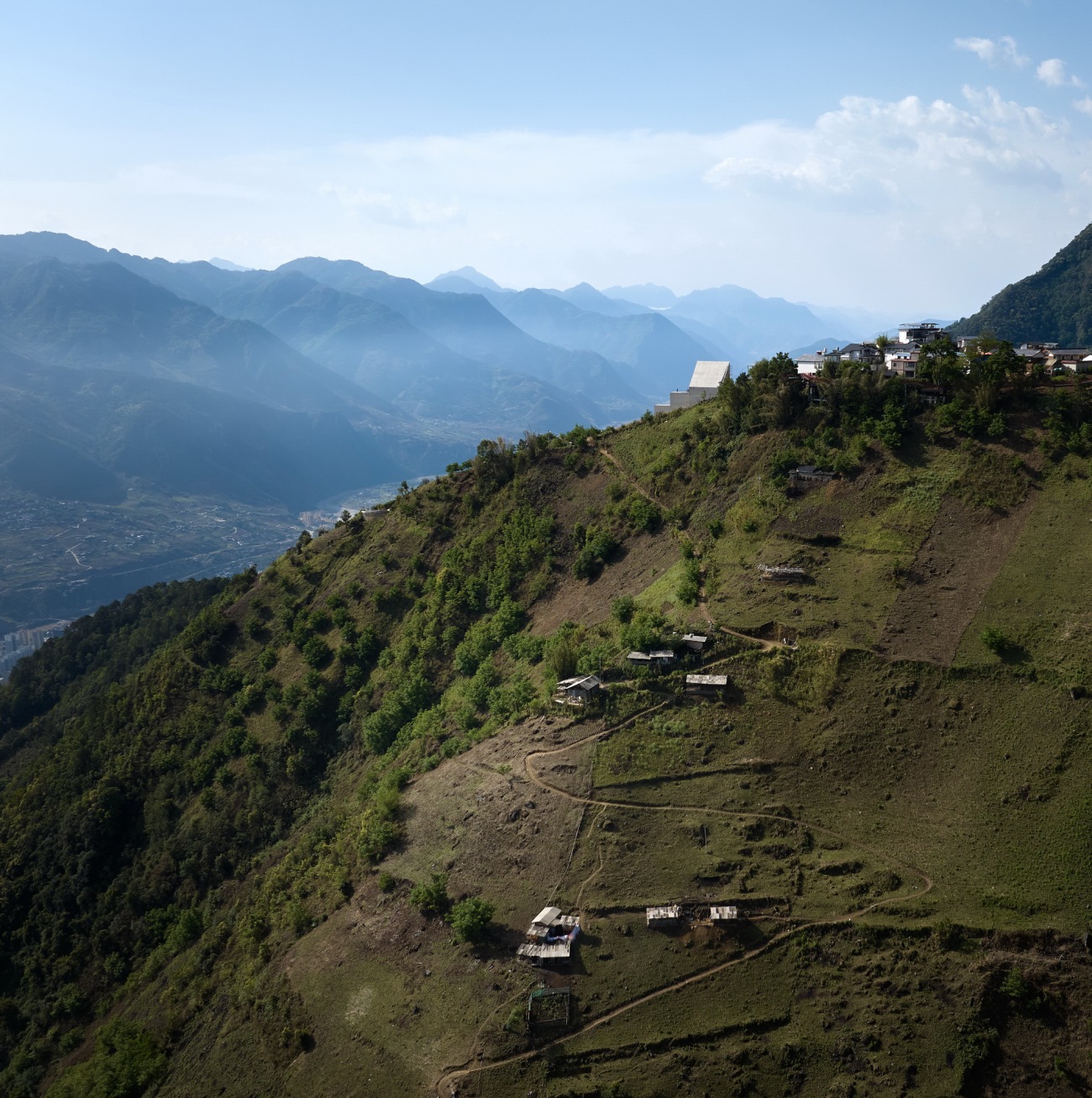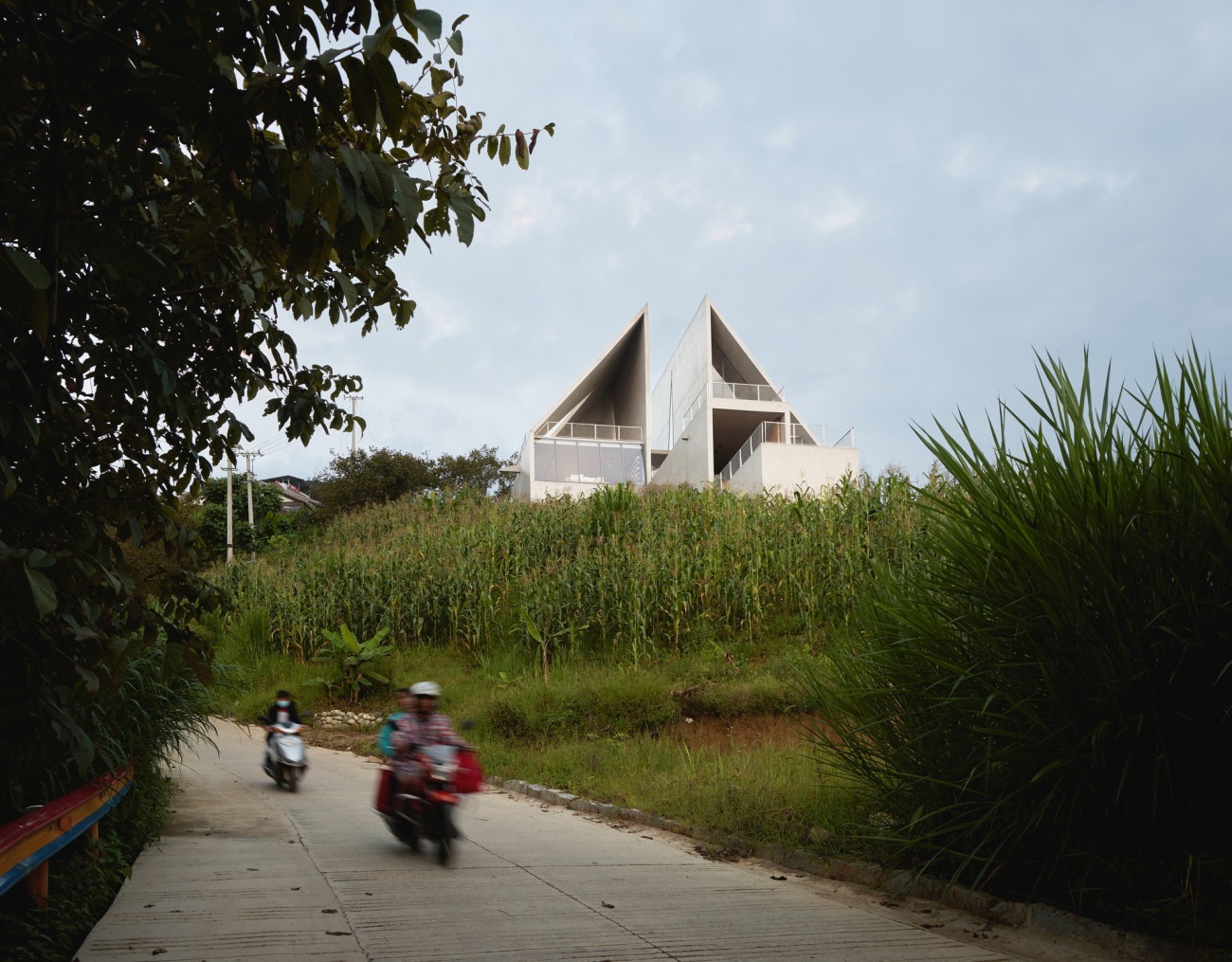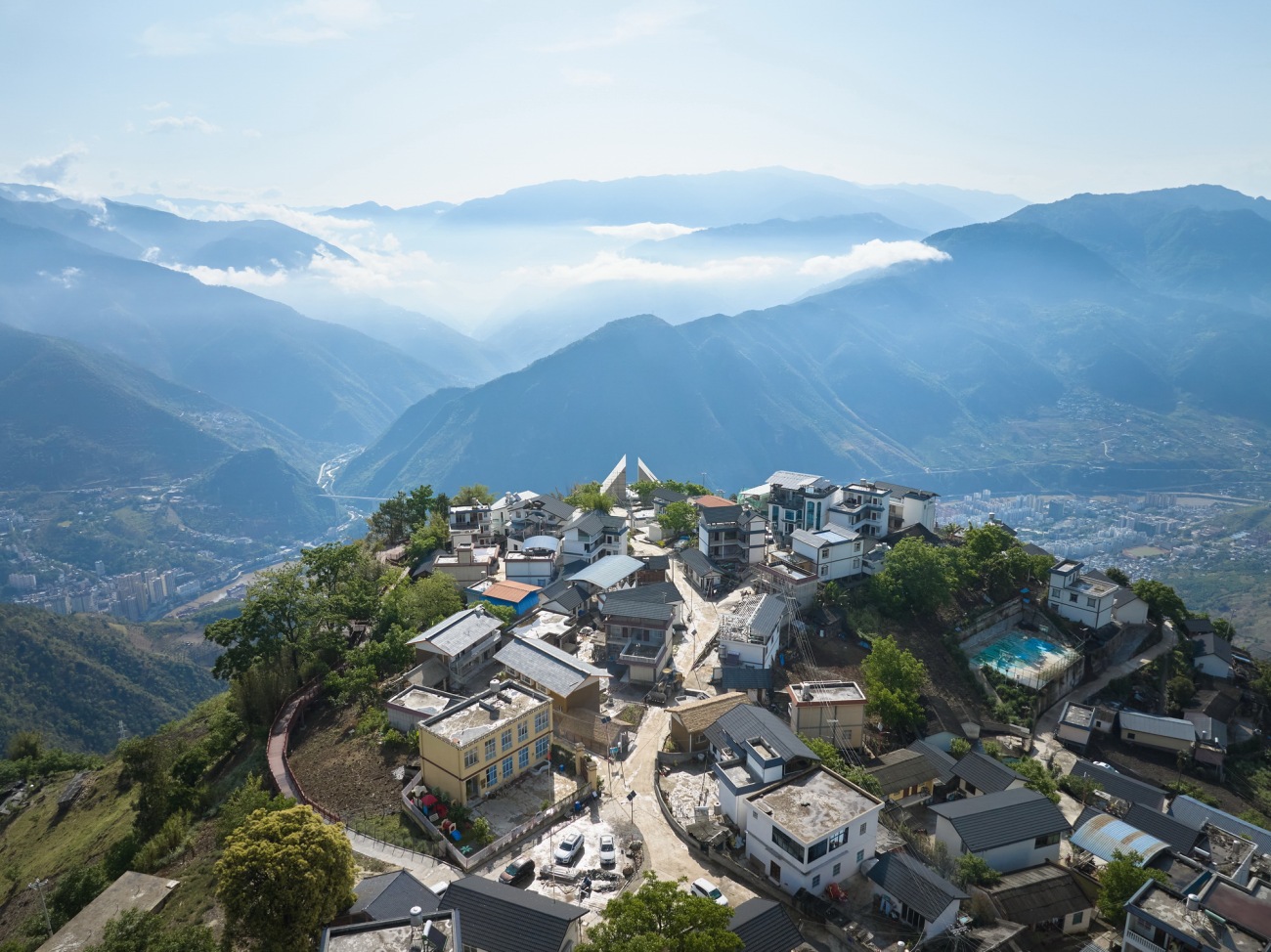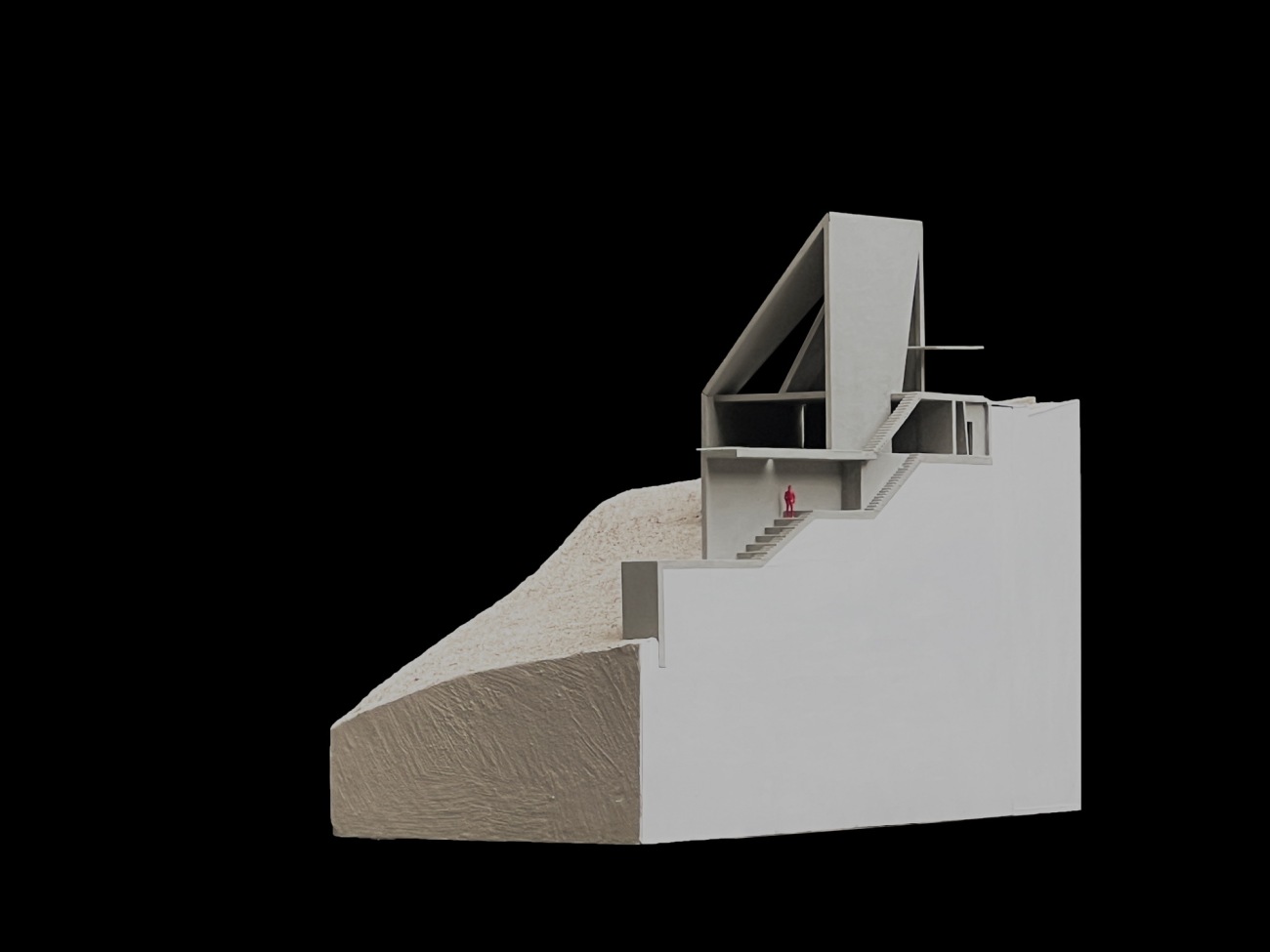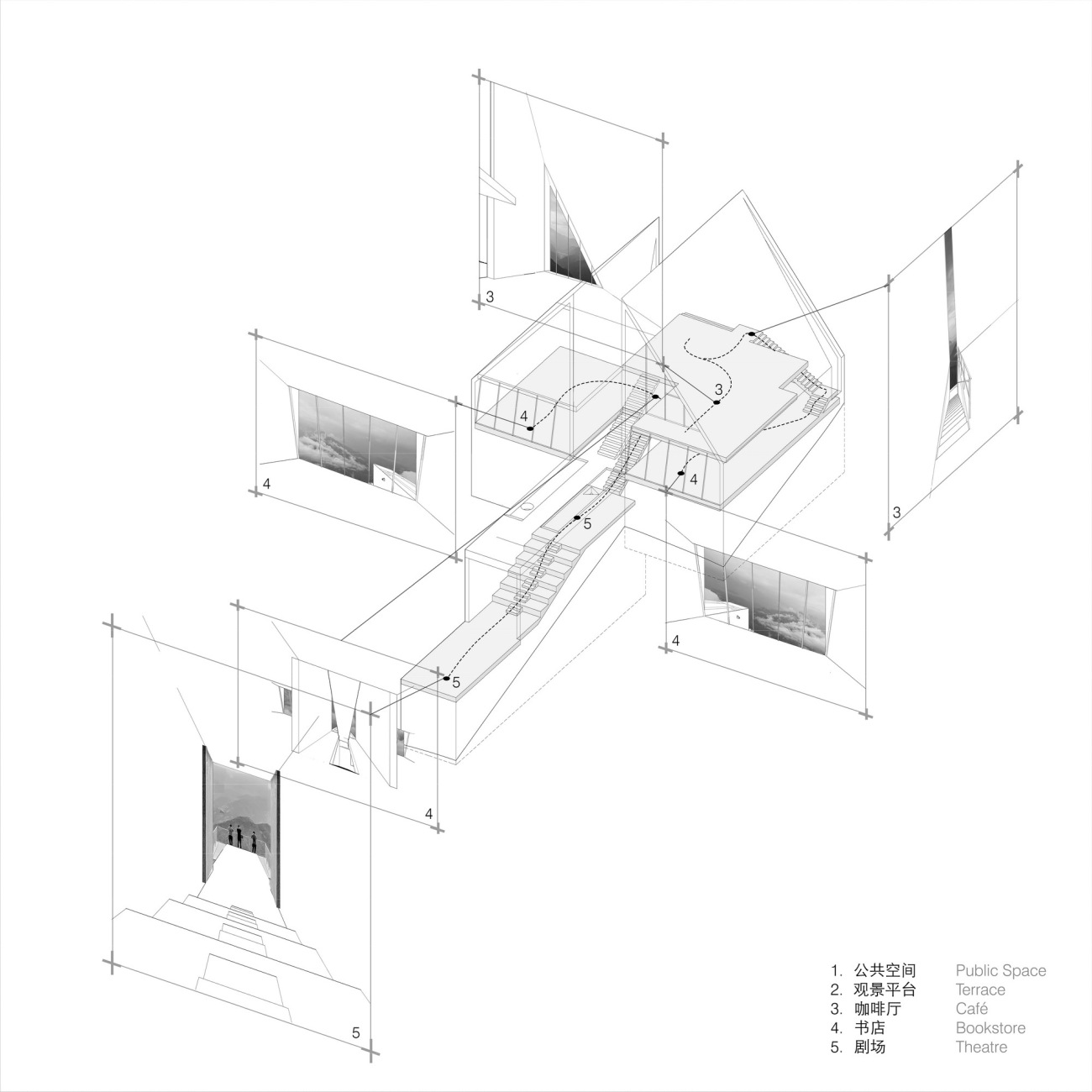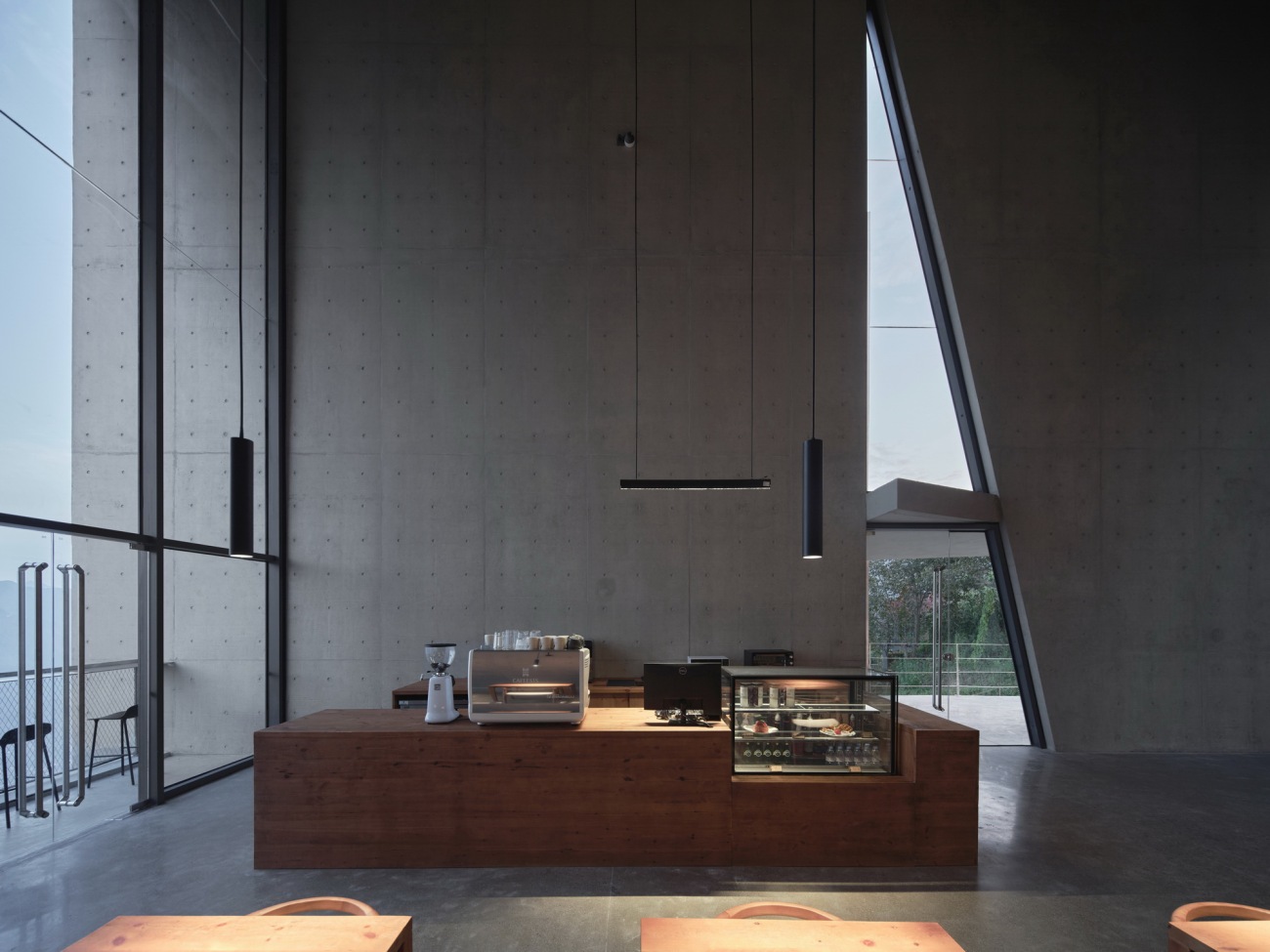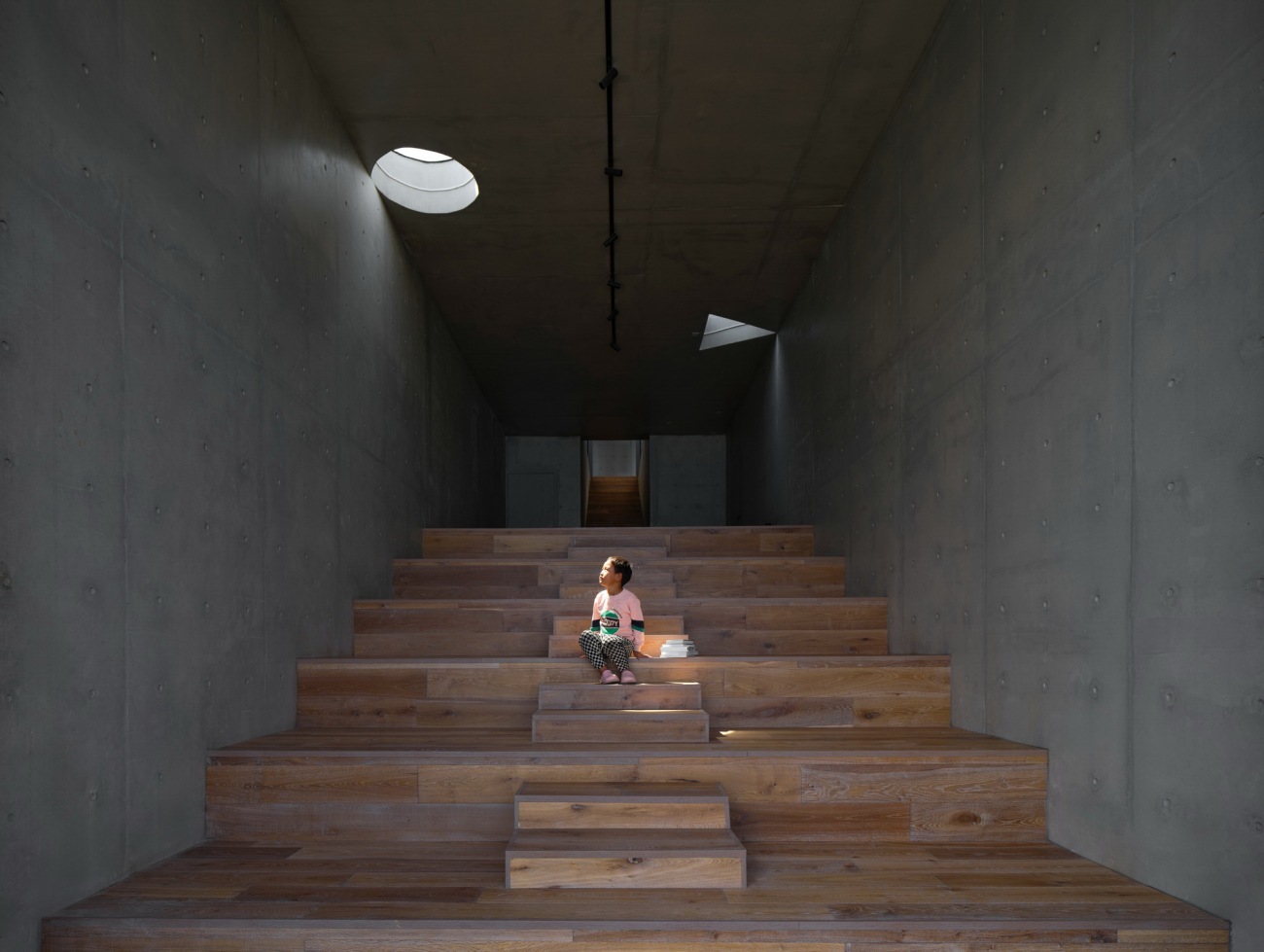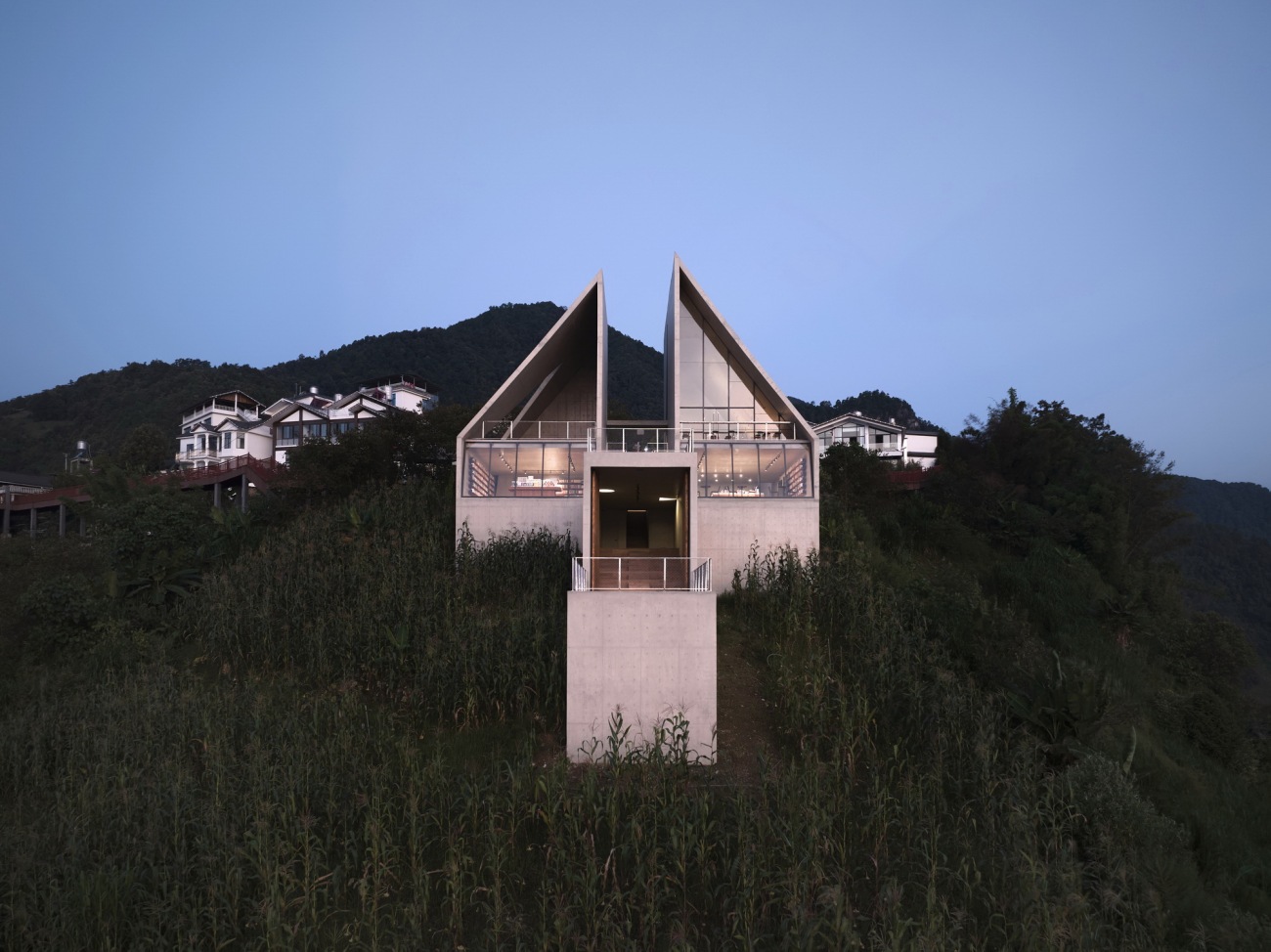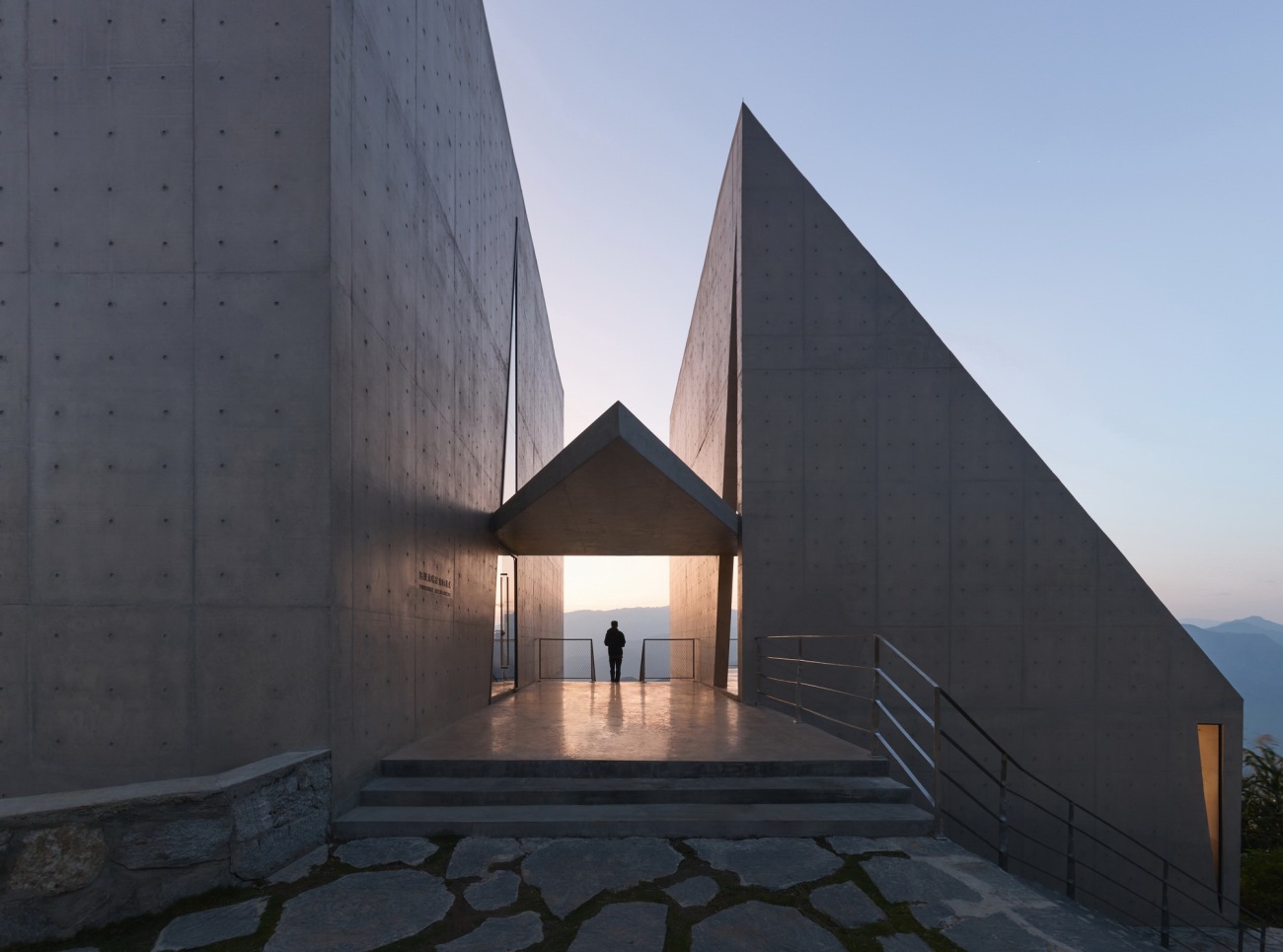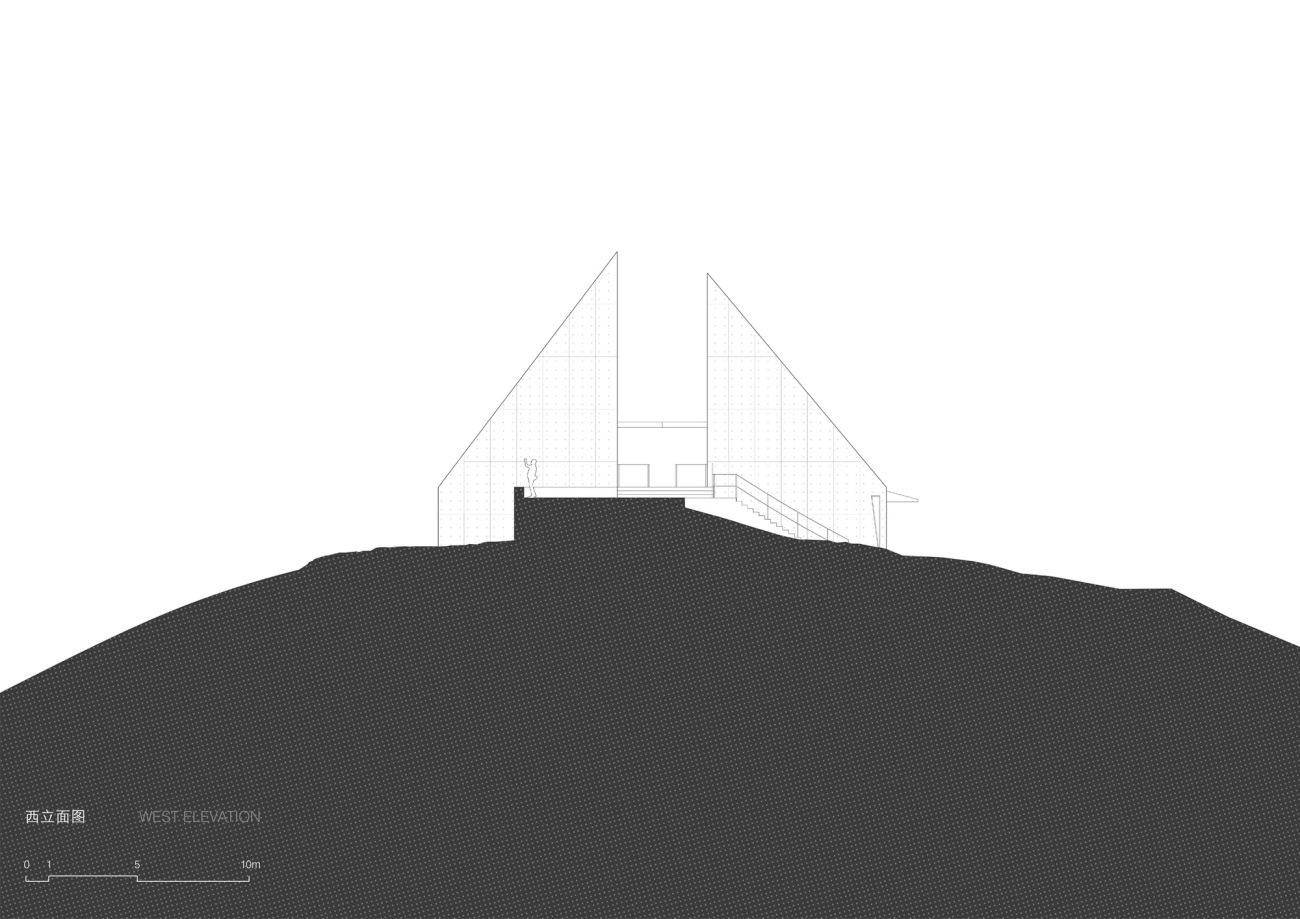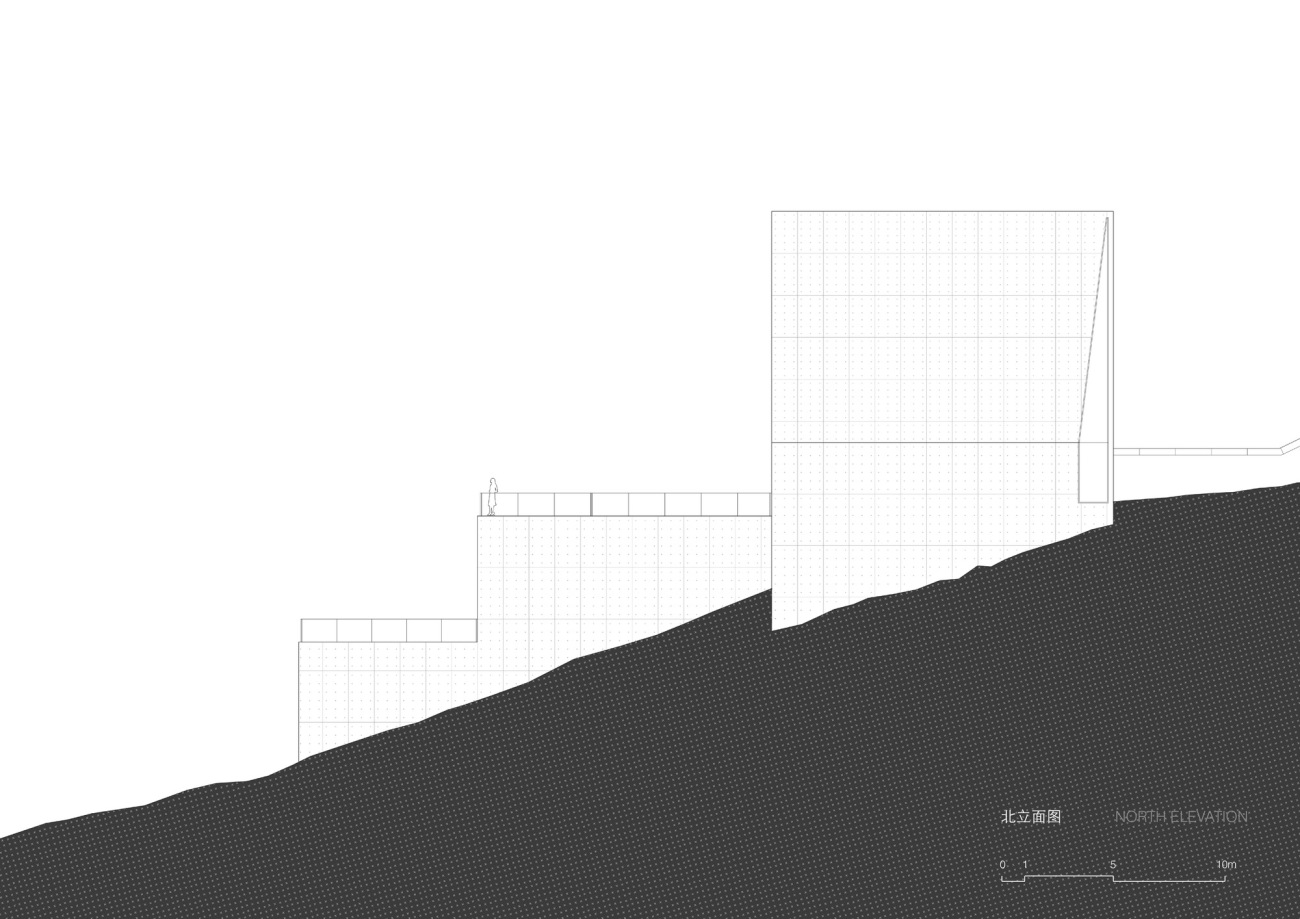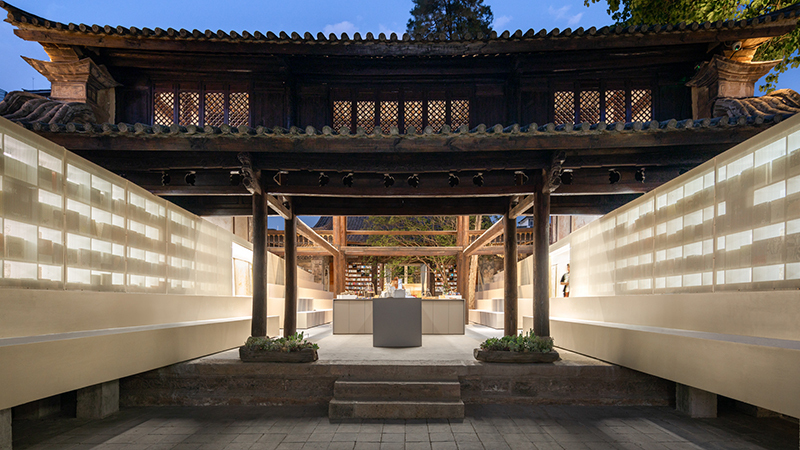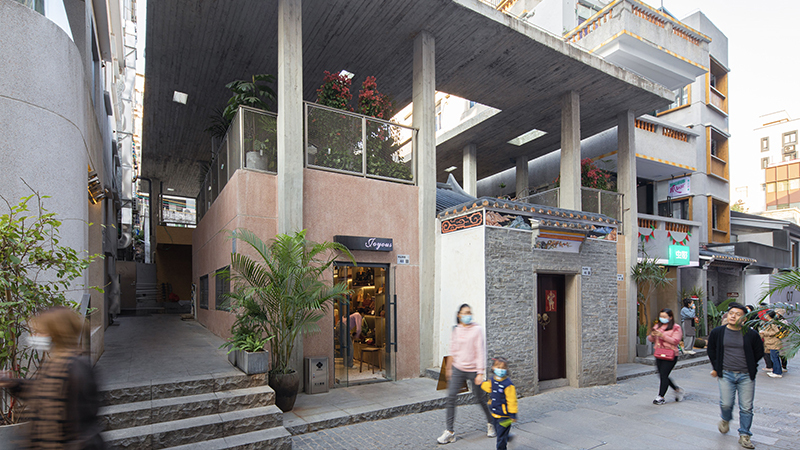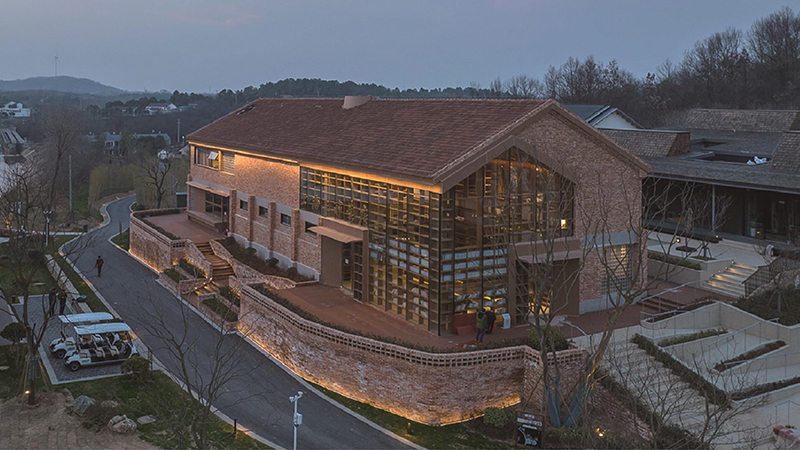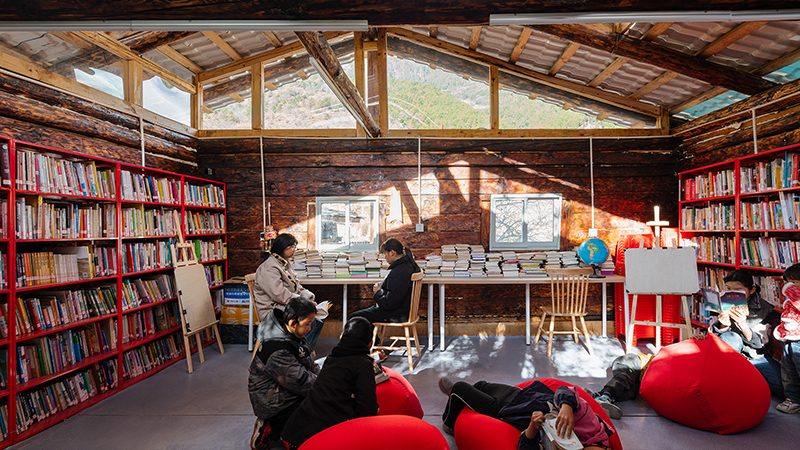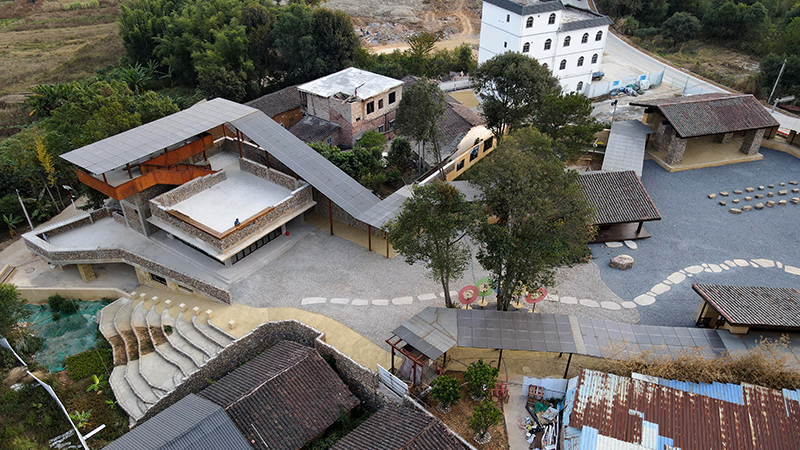| 公司: | 迹·建筑事务所(TAO) | 类型: | 建筑 |
|---|---|---|---|
| 地区: | 中国 | 标签: | 书店 |
▽书店远景
▽室外观景平台
▽观景平台
项目背景Project Background
作为中国境内最后一条没有水坝、自由奔腾的大河,怒江一路辗转穿梭,在滇西横断山脉的地表褶皱中分割出东西两侧的高黎贡山与碧罗雪山两大山脉。怒江大峡谷先锋书店,坐落在高黎贡山之巅,与傈僳族、白族的两座信仰之山隔江对望。
As the last free-flowing river in China without dams, the Nujiang River winds through the folds of the Hengduan Mountains in western Yunnan, separating Gaoligong Mountains and Biluo Snow Mountain to its east and west. The Nujiang Grand Canyon Bookstore of Librairie Avant-Garde is situated atop the Gaoligong Mountains, facing across the river toward the two sacred mountains of the Lisu and Bai ethnic groups.
▽村落与书店
2021年,TAO受先锋书店邀请,为其设计在怒江州境内的三座新店,而这也开启了TAO与先锋的第三次合作。本项目所在的泸水市,位于怒江南部,是怒江州的州府。整个城市被碧罗雪山与高黎贡山所怀抱,是怒江峡谷纵流而下的南大门,也是先锋在怒江逆流而上的第一站。
In 2021, TAO was invited by Librairie Avant-Garde to design three new stores in Nujiang Prefecture, marking the third collaboration. The site is in Lushui, the prefecture's capital city, situated in the southern part of Nujiang. Embraced by the Biluo and Gaoligong Mountains, the city serves as the southern gateway of the Nujiang Canyon as well as the first stop of Avant-Garde's upstream journey along the river.
▽场地位置
 |  | 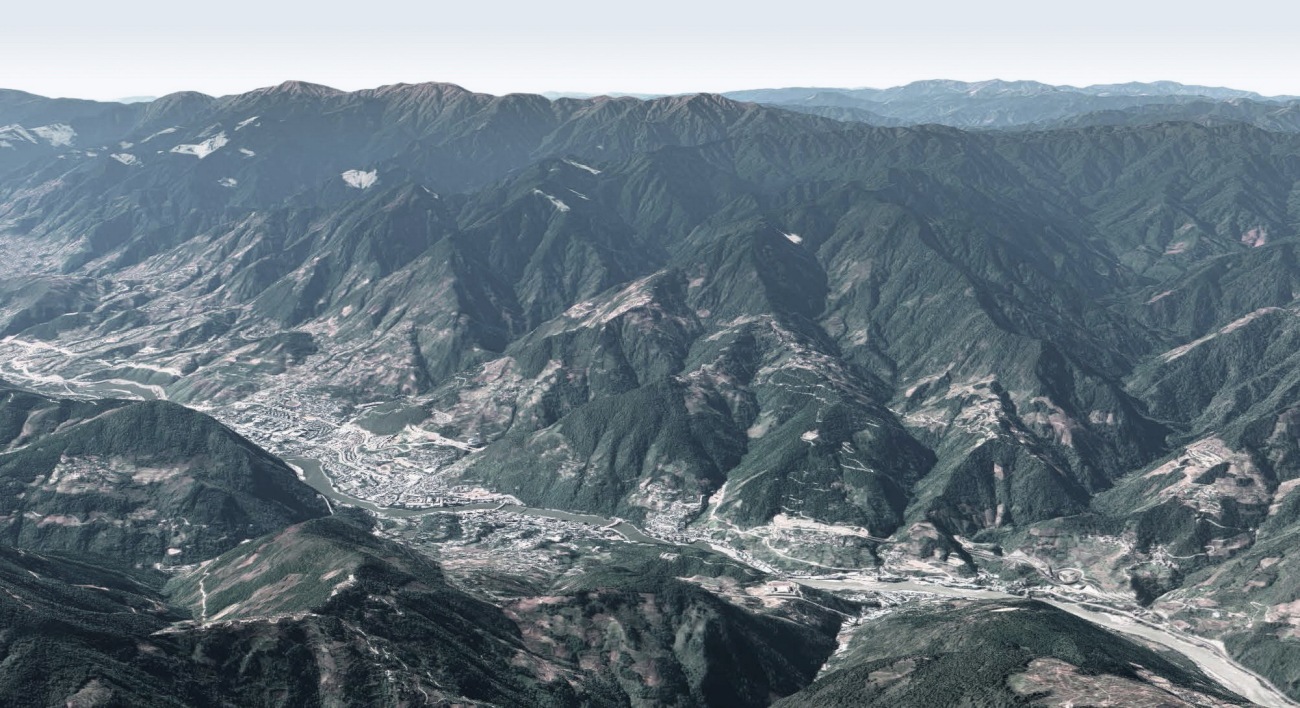 |
▽场地氛围
书店所在的阳坡村,坐落在高黎贡山的山脊,是一座傈僳族世代聚居的原始村落。傈僳族历史悠久,早年生活在川滇雅砻江、金沙江的广阔河谷地带。16世纪中叶,因战争威胁向滇西北迁徙,成为怒江流域的主体民族之一。高山峡谷的生存条件,促使他们创造相应的生产工具,其中以对弓弩与箭的使用为最。而傈僳族弓弩符号的民族图腾也成为了本项目的灵感来源。
Yangpo Village, where the bookstore stands, perches on the Gaoligong ridge. It is a primitive Lisu settlement for generations. The Lisu originally resided in the vast river valleys of the Yalong and Jinsha Rivers in Sichuan and Yunnan and migrated to northwestern Yunnan due to the war threat in the mid-16th century, forming one of the dominant ethnic groups along Nujiang River. Adapted to the harsh terrain, they developed distinctive tools, particularly crossbows and arrows, which became a cultural totem and a key inspiration for the project.
▽概念草图
▽1_400 场地模型
场地特征Site Features
本项目场地位于阳坡村面向峡谷的村口,天然具备了文明与自然之边缘的特征。在2021年,场地原有一处尚未竣工的观景台,直面怒江大峡谷的壮阔景观,是观赏峡谷横断山脉景貌的绝佳视点,后取名为“怒江大峡谷先锋书店”也正因如此。
The project is located at the entrance of Yangpo Village facing toward the canyon, naturally embodying the boundary between civilization and nature. The site originally had an unfinished viewing platform with a panoramic view of the canyon, offering a prime vantage point of the Hengduan Mountains, which also gave the name of “Nujiang Grand Canyon Bookstore of Librairie Avant-Garde.”
▽场地与村落
▽总平面图
特殊的场地条件为建筑师带来了最初的构想:一个向前伸出的体量。陡峭的坡度与高耸的山体,配合建筑体量的延伸,使书店成为了一个凌空的平台。身处书店的读者,被峡谷景观从北东南三个方向围绕,给人一种在云上漫步的奇妙感受。
The unique site conditions shaped the architect’s initial vision of a forward-stretching volume. The steep slope and towering mountains, combined with the protrusive structure, transforming the bookstore into a suspended platform. Readers within the space are surrounded by canyon views from the north, east, and south, creating a sense of walking among the clouds.
▽概念草图
▽书店远景
另一方面,场地条件决定了本项目未来将成为村口的标识,也是先锋书店的公众形象。这种情形下,建筑的标志性显得至关重要,它必须是一个醒目的、具有先锋气质的地标。同时它又要保持与村落的对话,有个性但也兼顾与场所的联系。
The prominent location also positions itself as the village’s landmark and the public face of Librairie Avant-Garde. Thus, the building must serve as a striking, avant-garde symbol while maintaining a dialogue with the village—distinctive yet harmoniously integrated with its surroundings.
▽鸟瞰
▽概念草图
建筑作为媒介Architecture as a Media
建筑以何姿态立于此处,如何平衡主体性与在地性,这个思考贯穿了整个创作过程。延展在高黎贡山山脊的傈僳族村落,场地环境本身同时具备了强烈的自然特征与文化立场,而建筑要同时对这两者进行回应。
How architecture balances individuality with local context is the central question throughout the design. The Lisu village stretching along the ridge of Gaoligong Mountains embodies both strong natural characteristics and cultural identity,
which architecture must respond to.
▽街景
作为一个傈僳族世代聚居的原始村落,阳坡村的民居分布依山就势,村落肌理保持着传统的山地特征。但同时,随着不同时期建筑的互相更迭与挤压,各个年代的建造痕迹在这里叠加,整个村落呈现出一种杂乱与拼贴的状貌。在错综复杂的历史场所环境中,书店建筑最终采用了完全当代的语言去回应村落普遍的坡屋顶建筑形态,这是一个基于当下建造语境高度抽象的表达方式。通过这样一种对话,书店也成为了连接村落的过去与当下的媒介。
As an ancestral Lisu settlement, Yangpo Village has developed organically along the contours, capturing the distinct texture of mountainous terrain. However, as dwellings of different periods have replaced and compressed one another, traces of construction from various eras overlap, resulting in a chaotic and collage-like appearance. Within the intricate historical context, the bookstore ultimately adopts a completely contemporary language to respond to the prevalent sloped-roof typology of the village, representing a highly abstract expression rooted in the present construction context. Through this dialogue, the bookstore also becomes a media that connects the past and present of the village.
▽村落俯瞰
在建筑本体上,斜向的空间构成了与山体环境的关联。耸立在村口的山坡上,建筑自身形体的倾斜与坡度,配合场地自身的陡峭,共同构成了场所中“箭在弦上,不得不发”的动势。建筑外墙上有多个开口的动作,他们出现在建筑不同的位置,面朝不同的方向,其形状也一如建筑的形体充满变化。漫步其中,会发现每个开口都对应着一个框景,是一个不同的峡谷景观。而透过这些洞口,每个读者凝神远眺的时候,建筑成为了链接人与天地的媒介。
The slanted spaces created by the structure establish a connection with the mountainous environment. Perched on the slope at the village entrance, the building's inclined geometry and steep gradient combine with the site's natural topography to form a dynamic momentum of “an arrow on the bowstring.” The exterior walls feature multiple openings oriented in different directions, whose shapes resonate with the building’s dynamic form. Each opening frames a unique view of the canyon landscape, through which the building becomes a medium connecting people with the sky and the land.
▽书店远景
▽建筑全景
▽概念拼贴
两条动线Two Circulations
建筑上下共三层,由两条内外分别的动线所串联。沿着动线在建筑内外漫游,会经历一个此起彼伏、不断变化的空间序列,体验时而狭长高耸,时而幽暗深邃,时而豁然开朗。
The building consists of three levels, interconnected by two separate circulation routes. Wandering along these routes inside and outside the building, one experiences an ever-changing sequence of spaces, where one encounters moments that are at times narrow and lofty, at times dim and profound, and at times spacious and airy.
▽1_50 手工模型
内部动线始于最上层高耸的咖啡区,指向天空的倾斜屋面,营造出类似宗教空间的精神体验。沿着室内台阶向下是中间层的图书区,由厚重的混凝土墙壁三面环绕包裹,为访客提供了面对大自然的庇护。顺着中央的台阶继续向下,钻入最下面一层的剧场空间,剧场内部被两个水面下的天窗照亮,波光粼粼。
Internal circulation begins at the lofty café on the top, with its sloping roof directed toward the sky, creating a spiritual ambience. Descending to the mid-level bookstore, visitors are sheltered from nature by heavy concrete walls on three sides. The lower-level theatre is illuminated by two skylights beneath the water surface casting a shimmering light.
▽室内流线分析
▽整体短剖面
▽入口
▽咖啡厅
▽书店
在剧场尽头,伫立着两扇6米高的樟子松木大门。大门每天开合一次,如同一场仪式。门内,人类在这里阅读、朗诵、与过往的灵魂对话;门外,怒江咆哮,大地沉默。大门撼动开合间,山峡成为了舞台的幕布,怒江与文学在这里碰面。
At the end of the theatre stand two 6-meter-tall camphor-wood doors which open and close once a day like a ritual. Inside the doors, people read, recite and engage with past souls; outside, Nujiang thunders with fury while the land rests in silence. The canyon unfolds as the stage's curtain, where the Nujiang and literature converge.
▽剧场
▽夕阳下的书店
外部动线从建筑入口开始,两个对峙的形体定义出狭窄而高耸的入口空间,恰如怒江被两侧耸立山脉所夹出的峡谷格局。从入口空间向前,沿着建筑的中轴线拾级而下,便豁然开朗,不知何时便已经从人工的“峡谷“来到了自然的峡谷之中。
The external circulation begins at the entrance, where two opposing forms define a narrow and elevated entry space, much like the canyon composition formed by the Nujiang River flanked by towering mountains on either side. Moving forward from the entry space and descending along the central axis, one suddenly transitions from the artificial "canyon" to the natural canyon, revealing a sense of openness.
▽室外流线分析
▽整体长剖面
▽入口
▽观景平台
▽通向室外观景平台
▽室外观景平台
从鸟瞰图上可以清晰的看出,建筑的主入口与阳坡村的主干道在同一条线上。室外动线连接起上下两层的观景平台,组合成为一个面向村民和访客永久开放的公共空间。从这个层面上,可以理解为书店是村落公共空间面朝峡谷的延伸,当代的建筑语言与传统的村落机理在这里得以交融。先锋书店,如其名字,站在阳坡村的村头,举起傈僳族的弓弩射向诗歌的远方。
It is clear from the aerial view that the main entrance of the building is aligned with the main road of Yangpo Village. The outdoor circulation connects the two viewing terraces on different levels, forming a public space permanently open to villagers and visitors. In this light, the bookstore can be understood as an extension of the village’s public space facing the canyon where contemporary architectural language merges with vernacular mechanics. Librairie Avant-Garde, as its name suggests, stands at the forefront of the village, lifting the crossbow of the Lisu people towards the far reaches of poetry.
▽村落与书店
▽夕阳下的书店
阳坡村,作为少数民族聚居地,先锋书店为她带来了现代人文的薪火。未来,以书店为支点,先锋将激活民族村的人文活力,撬动世界对少数民族与怒江大峡谷的关注。
Librairie Avant-Garde has brought the contemporary cultural spark to the ethnic minority settlement of Yangpo Village. Taking the bookstore as a fulcrum, Librairie Avant-Garde will further rejuvenate the village’s cultural vitality and draw global attention to both the ethnic minorities and the Nujiang Grand Canyon in the future.
▽夕阳下的书店
其他技术图纸
▽一层平面图
▽地下一层平面图
▽地下二层平面图
▽东立面图
▽南立面图
▽西立面图
▽北立面图
项目基本信息
项目名称:怒江大峡谷先锋书店
业主:先锋书店,泸水市文旅局
项目地点:云南省怒江州泸水市
项目功能:书店、观景台
设计单位:迹·建筑事务所(TAO)
主持建筑师:华黎
设计团队: 华黎、张鹏、刘兆瑞、张宇恒、Yue Tam、周晨玥、孙文昊、王佳豪
结构工程师: 马智刚、赵晓雷
机电设计: 吕建军及kcalin卡林机电设计:孙晶、李鑫
施工团队: 主体施工-泸水市建设开发投资有限公司; 混凝土修复-范曙明、朱飞飞; 室内-魏小刚、梁济刚、唐之刚、伏坤华、孟春梅、李仕彬
建筑面积: 637平方米
结构体系:剪力墙结构
设计时间:2022.1-2022.12
施工时间:2023.2-2024.9
摄影:奥观建筑视觉AOGVISION
Credits & Data
Project: Nujiang Grand Canyon Bookstore of Librairie Avant-Garde
Client: Librairie Avant-Garde, Lushui Culture and Tourism Bureau
Location: Lushui, Nujiang, Yunnan
Program: Bookstore, Viewing terrace
Principal architect: HUA Li | TAO (Trace Architecture Office)
Design team: HUA Li, ZHANG Peng, LIU Zhaorui, ZHANG Yuheng, TAM Yue, ZHOU Chenyue, SUN Wenhao, WANG Jiahao
Structural engineer: MA Zhigang, ZHAO Xiaolei
MEP engineer: LV Jianjun and Kcalin design group MEP engineer: SUN Jing, LI Xin
Construction team: Construction General Contractor - Lushui Construction Development Investment Co., Ltd.; Concrete Restoration - FAN Shuming, ZHU Feifei; Interior Construction Contractor - WEI Xiaogang, LIANG Jigang, TANG Zhigang, FU Kunhua, MENG Chunmei, LI Shibin
Floor area: 637 sq. m.
Structural system: Shear wall structure
Design:2022.1-2022.12
Construction: 2023.2 - 2024.9
Photograph: AOGVISION
更新日期:2024-10-12 16:45:36
非常感谢 迹·建筑事务所(TAO) 带来的精彩项目, 查阅更多Appreciations towards Trace Architecture Office for sharing wonderful work on hhlloo. Click to see more works!












